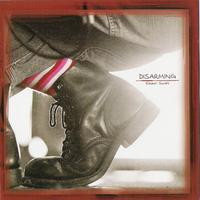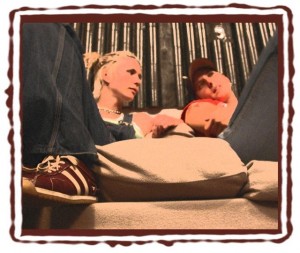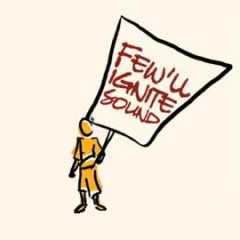"Disarming": Part 7
Okay, I’ve been writing these blogs for days now and even I’m getting bored! Are you? I hope not! You see, there are just too many albums! What’s more, there’s too much to say about each record. The torrent of memories that comes up for me while I’m listening to them makes each blog posting far too long. I swear, they could each be novellas! But what can I do? I will continue in this vein and hope you’ll forgive me for being so verbose.
Now that that’s off my chest… getting down to business… let’s talk about the 2004 release, shall we?
*************************************************************************************************************************************************************************
So, the summer of 2002 included several really amazing Canadian festivals with Michelle Josef. I particularly remember the Ness Creek Music Festival in Northern Saskatchewan and The Edge of the World Music Festival on the Queen Charlotte Islands of Northern, BC.
At the latter event, we were walking along the amazing beach of Haida Gwaii when Michelle told me that she was growing tired of the travel and needed to leave the band. We knew we would miss her, but we understood. Cheryl agreed to fill in for Michelle for our east-coast September tour, especially since this brought her out to see her family in Halifax, but she didn’t want to tour full-time again. We were in the lurch.
At our gig in Fredericton while touring with Cheryl, an old friend and drummer showed up to support our show: Adam Bowman. He was touring with another band and had the night off. We had known Adam for a few years by then as he had drummed with the now defunct Guelph (mostly) girl band Corduroy Leda several years earlier. At the time that we first met him, he was just a 20-year old kid starting out. There he was in Fredericton, 24 years old and with a few more years of experience under his belt. Lyndell and I, without even discussing it between us first, spontaneously asked him if he wanted a gig. Turns out he did!! Adam jumped onto our late fall tour with only a couple of weeks of rehearsals and a truckload of enthusiasm.
 When we first started working with Adam, it was strange to work with a guy again after so many years of being an all-girl band. What’s more, Adam had grown up in a small town, had never travelled west of Ontario, and had never eaten sushi (for example). What he lacked in life experience, however, he made up for in heart. In that first year of working with us, he instantly got a crash course on feminism, queer culture, full-time touring, political activism, etc. He became a bit like our little brother.
When we first started working with Adam, it was strange to work with a guy again after so many years of being an all-girl band. What’s more, Adam had grown up in a small town, had never travelled west of Ontario, and had never eaten sushi (for example). What he lacked in life experience, however, he made up for in heart. In that first year of working with us, he instantly got a crash course on feminism, queer culture, full-time touring, political activism, etc. He became a bit like our little brother.
Oh, and I’m proud to say that I’m one of the few who knew Adam when he had hair!
In early 2003, we returned to Australia twice, once in December-January and again in March-April. I believe Cheryl came with us on the first trip and Adam came with us on the second, simply because our working relationship with Adam was still a bit too fresh for what was becoming our most important performance market (Australia). Come March, however, Adam had taken over as the principal drummer and we were creating magic.
Adam brought with him an appreciation for funk and groove music that influenced our next collection of songs and truly brought the music into new territories. He played the show with an organic drum kit as well as an electronic drum pad on which we could program additional sounds and trigger sound effects. Songs that were featured on Disarming that show off this extra feature include “Tapped & Wired” (that 1980’s snare sound) and “Pek” (with the timpani sounds.)
When Adam came on board, I must admit, we were in a slump. Too many years of doing our own bookings, management, and promotion was getting us down and we were tired. The song “Boise” in the collection is a co-write with Lyndell that really speaks to this state of mind.
It seems that something always swooped in to lift our spirits in these times, however, because at the end of that first fall tour with Adam we had a spontaneous meeting with a prominent Booking Agency out of Ann Arbor, MI called Fleming & Associates. We had submitted our material to them a few years earlier with no response but here they were now pursuing us. They had become aware of our track record, one of their employees had seen us play at a festival, and they wanted to negotiate working with us.
It was like a gift from the heavens. They handled bookings in North America, exclusively, so we finally had a service provider that would give me a chance to not have to balance my laptop on my knees in the van all the time! Also, it turned out that they don’t take unsolicited packages and so they hadn’t even realized we had sent our material to them a few years earlier! We signed a contract with Fleming right then and there and continued to work with this company for five great years. They’re all fantastic people and I have a lot of respect for them.
“Disarming,” as a collection of songs, was mostly written after a particularly political phase in my life. Travelling around the US after September 11th, 2001 with Michelle Josef was an amazing experience for Lyndell and me. Michelle is particularly politically minded and she regularly brought with her great articles and magazines, and also picked up a different newspaper daily. As a result of this van dialogue, we became even more vocal at our gigs about what was happening with the US administration (i.e. what I call the “shrubbery years”) with their “war on terror,” not to mention what was happening concurrently in our own country regarding civil rights and natural resources.
On a personal front, after several years of being together in some context (first as friends, then as lovers, later as partners), Lyndell and I were finally living together in Toronto in an apartment on Bartlett Street on the west side of the city. It was this space that we showcased in the liner notes with an amazing art piece created by Misty Winter who was both the artist and the photographer for the graphic design.
For me, the title of the album was both about the notion of disarming a country and a movement—that call for real peace rather than the rhetoric of “bombing for peace”—as well as the need to disarm our own selves, open ourselves up, learn to be more honest and true and less defensive. I was on this journey in my own personal life and it was easily transferred to larger, global issues.
We approached a friend named Sean Gregory about recording this record. I had known Sean for years and knew of his studio called The Recording House, having done some demo work with him there in 2001. I finally felt it was time to work with him in a more formal manner.
When I asked Sean what he remembered about when we met, he wrote this:
“When I first opened my recording studio back in 1997, I was looking around for artists that I’d like to work with and I remember coming across a review of your 1997 release “Insect Inside” in a local Toronto indie music magazine. The internet wasn’t as evolved as it is today obviously, so I couldn’t go online and listen to your music. All I had to go on were the words in the review. I found it quite intriguing, so I contacted you via snail mail and found out when you’d be playing a gig in the city so I could go check out a live show.
The very first time I met you in person was in a tiny little club in Toronto called Holy Joe’s. My first impression of you was that you were very serious about what you were doing and when I heard you sing that night, I was blown away. I was so impressed with your voice, it was just amazing and I found your music to be very refreshing as I was listening mostly to rock, metal and contemporary pop at the time.
Although it wasn’t anything like I had done before, I was very interested in working with you because I thought you were all so talented as musicians, singers and songwriters. And I was also very much attracted to the level of professionalism and most importantly, the passion and enthusiasm that you showed for your music. And of course, it was a great opportunity for me to learn and grow as a producer, engineer and musician and for that, I thank you!”
We started working on “Disarming” in August of 2003. Sean even remembered the exact date, which is awesome because my memory is not that good: Sunday August 10th , 2003. We worked straight through that week until Thursday, August 14th at around 4pm when the big blackout occurred in Toronto (and across the whole Eastern seaboard).
When we finally realized that the lights weren’t going to come back on, we ended the session and drove home (back west from Scarborough) to a transformed city. We enjoyed that black night in Toronto like no other we had ever enjoyed before. The city was alive with dancing on the streets. There were neighbourhood barbecues, telescopes and fire twirling in the park, and so much kindness and camaraderie between Torontonians. It was a beautiful evening to be remembered for always. Afterwards, we would regularly wish that the city would enforce blackouts regularly just for the sake of community togetherness (and energy savings)!
I asked Sean what challenges he remembers from the sessions and he wrote this:
“It was the largest off-the-floor session I had ever done and getting everything set up and working and getting all of you guys comfortable with your instruments and headphone mixes was no easy feat.
Adam Bowman had a full acoustic drum kit and a few lines of electric drums as well. We recorded the bulk of the album in two major off-the-floor sessions and he used a different kit for each session. For the first session he used a Yamaha kit and for the second he used an Ayotte kit. Lyndell was playing bass, electric violin and a bowed acoustic guitar, sometimes recording more than one instrument within a single take. And I found it challenging to mike your acoustic guitar and voice at the same time because of the bleeding of sound into all the microphones that occurs when you record two or more sources in such close proximity. It was a tough job to find the right mike placement to get a good balance. Once everything was set up and you guys started playing though, it was music to my ears!”
I liked hearing this with such clarity and detail (again, another kudos to Sean’s memory) because I hadn’t recalled that we had, once again, challenged our engineer with an off-the-floor session! We are crazy, aren’t we? I guess we were just so familiar with doing it this way that we continued in that vein with each recording. When I listen back to these recordings, though, I’m impressed with our ability to all play together without having to overdub our parts. That’s probably a credit to our tightness from the multitudes of live shows that we were doing at the time!
He also recalled that Cheryl joined us in the studio for one of the songs, thus making it three different drum kits that Sean had to deal with! Sorry Sean!!:
“Cheryl Reid also brought in a full acoustic drum kit to play a track called “Breath.” She was using brushes and making those soft swirly sounds on the snare drum and cymbals. Because she was supposed to play that song with such a soft dynamic, it was a challenge to get the levels just right on the kit without introducing too much noise. I think that track came out great though and I absolutely love how she played the song!”
Those sessions stretched out over several months and took place between touring commitments. Our final recording date, including all the mixing, was December 18th, 2003.
Other guests in the studio included Brenley MacEachern and Lisa MacIsaac of Madison Violet who sang back-ups on “Tapped & Wired” as well as Sean Gregory, studio owner himself, who played electric guitar on one of our rock inserts.
Oh yes, the inserts. Who could forget about those? The goal of this album was to create a continuous play record from start to finish. We were all about smooth transitions and consistent set lists on stage at this time and almost each song had its own transition into the next. Using the “negative track” system (where a piece of music can be hidden in the space between one CD track and the next), we stuck these inserts in between each song so that people could hear little treats when they listened to the record from start to finish on a standard CD player.
What I didn’t take into consideration, however, was the rise in popularity of digitizing tracks. When these songs were ripped into a computer, the track’s transition into the next song would be tacked onto the end of each track, giving each song a feeling of never really being over and cutting off unceremoniously. This also happened to anyone who downloaded single tracks and to any radio station who played any individual tracks from the record. Because it all ran together, it was impossible to instruct the radio announcers to shut it off after a certain time code, for instance!
I don’t recommend this “bright” idea, I must say. Cool in concept, but not practical in today’s digital world.
On a technical level, Sean wrote the following and I must quote him because it’s not something I would have even known how to write:
“When we did ‘Disarming,’ we recorded to hard disc using Nuendo version 1.6. That was around the time I had just made the transition from ADATs to a DAW and I was still using the ADATs as I/O converters via their lightpipe technology with a Steinberg 96/52 Digital I/O card.”
All I know is that it was the first all computer-based recording that we did and I really enjoyed how visual it all became on the screen!! In fact, that was the recording that started my interest in the art of recording. I was so intrigued by the “sound clouds” and how seemingly easy it could be to create layers with this digital medium. It took me many years to actually put that curiosity into practice however, but at least I have the 2009 release, “Lentic,” to show for it!
 Now, getting back to this album’s graphics, as I mentioned above, the insert features original artwork by Misty Winter who shot a series of photographs throughout the main floor of our apartment, pieced them together, painted in the missing parts, and then created a 5’X2′ large wall-mounted piece on canvas for us. I then got it photographed professionally and we reduced it to the length of the liner notes. I still have that original artwork, too, although it’s too large to bring to China and it really has no place for display. It’s in storage at my sister’s house. Misty’s is still hanging on her wall in Chicago, though. Oh that Misty Winter—what a talent!
Now, getting back to this album’s graphics, as I mentioned above, the insert features original artwork by Misty Winter who shot a series of photographs throughout the main floor of our apartment, pieced them together, painted in the missing parts, and then created a 5’X2′ large wall-mounted piece on canvas for us. I then got it photographed professionally and we reduced it to the length of the liner notes. I still have that original artwork, too, although it’s too large to bring to China and it really has no place for display. It’s in storage at my sister’s house. Misty’s is still hanging on her wall in Chicago, though. Oh that Misty Winter—what a talent!
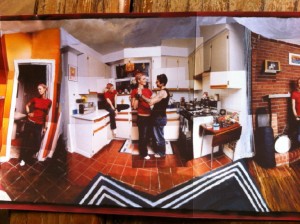 Also, the graphic design layout was done by someone new this time. After working in conjunction with Suzy and David for so long, we all thought it was time for a change. We had met and become good friends with Liane Blad in New Hampshire and she had done some design work for us already, so I approached her about designing the album’s liner notes. We worked across distance and I proofed everything electronically. By then, too, film was no longer required by CD manufacturing houses, so everything had become easier. Liane’s ideas, as well, were fresh and clean. I really enjoyed working with her.
Also, the graphic design layout was done by someone new this time. After working in conjunction with Suzy and David for so long, we all thought it was time for a change. We had met and become good friends with Liane Blad in New Hampshire and she had done some design work for us already, so I approached her about designing the album’s liner notes. We worked across distance and I proofed everything electronically. By then, too, film was no longer required by CD manufacturing houses, so everything had become easier. Liane’s ideas, as well, were fresh and clean. I really enjoyed working with her.
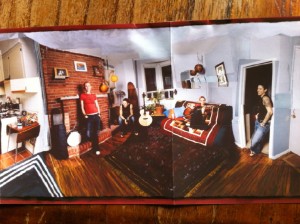 For the first time, too, I did not do a crazy fold, cut or origami riddle with this album. I did, however, invest a lot more in packaging and go with the (then new) fully cardboard design (i.e. no plastic). It was almost $4000 then to manufacture 1000 units, but we invested in the first run because it was so beautiful and special. The follow-up units were manufactured in the same plastic jewell cases as the previous albums, though, because we couldn’t afford it any other way. The first run made for a collector’s edition, if nothing else.
For the first time, too, I did not do a crazy fold, cut or origami riddle with this album. I did, however, invest a lot more in packaging and go with the (then new) fully cardboard design (i.e. no plastic). It was almost $4000 then to manufacture 1000 units, but we invested in the first run because it was so beautiful and special. The follow-up units were manufactured in the same plastic jewell cases as the previous albums, though, because we couldn’t afford it any other way. The first run made for a collector’s edition, if nothing else.
I recall some mastering woes on this record, however, and I re-mastered it to bring out the band more for the second pressing onwards. I felt that the vocals were too far forward overall and the re-mastering definitely helped, I remember.
Sean ended his interview with these thoughts:
“And in addition to all of the above, I’d like to say that my favourite track on “Disarming” is FAQ. I really loved the idea behind that song, having all the most popular questions you’ve heard from fans on the road at the beginning and all the answers to those questions at the end… It definitely gives people a sense of what it would be like for a touring musician like yourself out on the road going through all kinds of different places and meeting all kinds of different people. And it’s just a fun song! Brilliant!”
I concur that that’s definitely one of the more fun songs on this record. It’s fun in concept and it’s also interactive because the questions and answers are delivered in the exact same order; so, questions 1-15 are followed by answers 1-15, for example. If a person were to count the questions as they’re asked and remember the number of the one they’re really curious about, then they just have to count the answers as they’re delivered and their curiosity will be quenched! I’ve posted that song here for your listening (and counting) pleasure!
All in all, I almost kept my promise. I released this record in April of 2004, three months shy of two years after the release of “Stiltwalking.” I have absolutely no memory of where we did the release party, however. I really can’t remember! I’m thinking it may have been Hugh’s Room again, but that’s because I can’t recall how many records we’ve released there since “Stiltwalking”!
After that record came out, though, everything started to shift. We had continued to tour in Australia and throughout North America, but were becoming more and more disillusioned with living in Toronto and renting an expensive place with its separate office space in which our employees spent more time than we did! I was considering moving to Montreal as a result of new business associations there. Lyndell didn’t know what she wanted. We just knew that Toronto was no longer making us happy and something had to change in our lives. After all, “Saint Eddie” had been stolen from our street corner that past December and we now had “Leopold, the 4th,” a Chrysler maroon van in its place. In our discontent with Toronto and the pace of our lives, we nearly split up once again, but instead chose to buy a home together in the countryside about an hour West of Montreal and East of Ottawa. Our employees continued to work for Few’ll Ignite Sound, but now from home. It was a whole new lifestyle change that, once more, sparked a whole new round of songs.
But, I’ll talk about those tomorrow.






